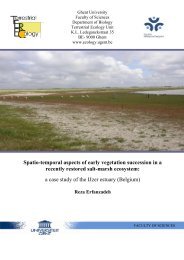PhD Arthur Decae 2010 - Ghent Ecology - Universiteit Gent
PhD Arthur Decae 2010 - Ghent Ecology - Universiteit Gent
PhD Arthur Decae 2010 - Ghent Ecology - Universiteit Gent
Create successful ePaper yourself
Turn your PDF publications into a flip-book with our unique Google optimized e-Paper software.
Description: L. Koch 1882 described both sexes and figured the male palp. Koch's<br />
descriptions are elaborate and accurate, but lack detailed information on the morphology of<br />
the embolus, clasper, fang structure, spermathecae and spinnerets that is of diagnostic<br />
importance. Supplementary information on these aspects is provided here, as well as<br />
measurements of some body parts and figures that are considered to be of diagnostic value.<br />
Figs. 13-19 Nemesia brauni L. Koch, female. 13 habitus dorsal; 14 habitus ventral; 15 carapace, lateral; 16<br />
eye-formation, dorsal; 17 patella and tibia III, prolateral; 18 spinnerets, ventral (note absence of PMS); 19<br />
spermathecae, dorsal. Scale lines = 2mm (13-15) 1mm (16-18).<br />
Male (n= 1): BL = 15.6, CL = 6.6, CW = 5.4. Leg IV: M4>T4>F4. PSP: p = 1-1; I = 2-2; II =<br />
1-2; III = 2-2; IV = 1-1. Body dorsally as in Fig. 9. Carapace longer than wide, CL/CW = 1.2.<br />
Similar to female in distinct morphological characters such as large size, absence of PMS,<br />
relatively wide clypeus (Clyp =0.39), shape of eye-formation (AR/PR = 0.96; AR/El = 2.00),<br />
and presence of lighter longitudinal zones on basal segment of chelicerae clothed with silvery<br />
white pubescence. The male studied differs from the females in having a low caput, an<br />
irregular serrated fang ridge (Fig. 8), and presence of dorsal spines on metatarsi and tibiae I<br />
and II. It differs also in relative lengths of segments in leg IV and prolateral spine pattern on<br />
patellae. Embolus (Figs. 10-11) neither shortened nor elongated; tip sigmoid, curved, and<br />
furnished with three tiny denticles (Fig. 10a), evident when embolus examined under high<br />
magnification in retrolateral view. Clasper as in Fig.12.<br />
Female (n=8): BL = 20-26, CL= 7.3-9.2, CW =6.2-7.9. Leg IV: T4>F4>M4. PSPvar: p = 0; I<br />
= 0; II = 0; III = 0; IV = 0. Dorsal aspect (Fig. 13). Carapace slightly longer than wide,<br />
CL/CW = 1.1-I.2, caput strongly elevated (Fig. 15), Ch/Th = 2.2-2.7. Clypeus wide, Clyp =<br />
0.43-0.65. Eye-formation (Fig. 16): posterior row slightly longer than anterior row, AR/PR =










